The family Oriolidae comprises the figbirds in the genus Sphecotheres (found in wooded habitats in Australia, Papua New Guinea and the Lesser Sundas), and the Old World orioles in the genus Oriolus. The family is not related to the New World orioles, which are icterids, family Icteridae.
The orioles and figbirds are medium sized passerines, around 20–30 cm in length, with the females only slightly smaller than the males. The beak is slightly curved and hooked, and as long again as the head. The plumage of most species is bright and showy, although the females often have duller plumage than the males do.
Orioles are monogamous, breeding in territorial pairs. Nesting sites may be chosen near aggressive species such as drongos, shrikes or friarbirds, which confer a degree of protection. The nest is a deep woven cup suspended like a hammock from a branch. They usually lay two or three eggs, but as many as six have been recorded. Both sexes incubate the eggs.
The family is distributed across Africa, Europe, Asia, and Australia. The few temperate nesting species are migratory, and some tropical species also show seasonal movements.
Orioles are arboreal and tend to feed in the canopy. Many species are able to survive in open forests and woodlands, although a few are restricted to closed forest. They are opportunistic omnivores, with the main components of their diet being fruit, berries, arthropods and nectar.
They are swift fliers. Orioles have clear calls and some are very good mimics.
Africa Wild Bird Book
Africa Wild Bird Book - The Second Edition
Family Oriolidae (Orioles)
Oriolus oriolus Eurasian Golden Oriole 543
Oriolus auratus African Golden Oriole 544
Oriolus chlorocephalus Green-headed Oriole 546
Oriolus larvatus Black-headed Oriole 545
Oriolus oriolus Eurasian Golden Oriole 543
Oriolus auratus African Golden Oriole 544
Oriolus chlorocephalus Green-headed Oriole 546
Oriolus larvatus Black-headed Oriole 545
African Golden Oriole
544. African Golden Oriole Oriolus auratus (Afrikaanse Wielewaal)
Order: Passeriformes. Family: Oriolidae
Description
Size medium: 20-21 cm. Legs and feet grey.
Male: Bright yellow except for black central rectrices, eyestripe and wingtips (European Golden Oriole has black lores, not eyestripe, black wings and black tail with yellow tip only). Iris deep red. Bill dark brownish pink.
Female: More greenish yellow above than the male; below dull yellow, streaked olive. Iris brown. Bill black.
Juvenile: Similar to adult female; wing coverts edged greenish yellow; eyestripe olive (no yellow feather edging or olive eyestripe in immature European Golden Oriole).
Similar species: A brighter yellow bird than Eurasian Golden Oriole. The African Golden Oriole is distinguished from the Eurasian Golden Oriole by having the black eye streak extend well behind the eye.
Distribution
It occupies large areas of sub-Saharan Africa, absent from lowland forest and arid areas. In southern Africa it is fairly common in Zimbabwe and northerly Mozambique, Botswana and Namibia, scarce in the Limpopo Province.

Habitat
Mainly canopy of Brachystegia woodland; also dense bush around hills, riverine forest of major river systems; less often also in savanna. It may also move into more arid savanna and suburban gardens.
Diet
It feeds on insects and fruit, mainly foraging among the tree canopy in mixed species flocks, occasionally coming down to ground level.
Breeding
The nest is woven cup made of dry grass and plant detritus held together with spider web, about 8-9 cm wide and 5.0-5.5 cm deep. It is slung between the two branches of a fork, usually 5-13 m above ground, well away from the main trunk of the tree. Egg-laying season in Zimbabwe is from August-January, peaking from September-November. Eggs are buffy pink, boldly spotted with chestnut, brown and grey, suffused with deeper pink around each brown spot. It lays 2-5, usually 2-3 eggs, which in one study were incubated for 17 days. The chicks are fed by both parents, leaving the nest after at least 15 days.
Call
Call: a Jay-like screech. Song: fluting fee-ooo fee-ooo.
Status
Uncommon breeding intra-African migrant, August to April (rarely to May); winters tropical Africa, but some birds overwinter in S Africa, especially in lowveld.
Order: Passeriformes. Family: Oriolidae
Description
Size medium: 20-21 cm. Legs and feet grey.
Male: Bright yellow except for black central rectrices, eyestripe and wingtips (European Golden Oriole has black lores, not eyestripe, black wings and black tail with yellow tip only). Iris deep red. Bill dark brownish pink.
Female: More greenish yellow above than the male; below dull yellow, streaked olive. Iris brown. Bill black.
Juvenile: Similar to adult female; wing coverts edged greenish yellow; eyestripe olive (no yellow feather edging or olive eyestripe in immature European Golden Oriole).
Similar species: A brighter yellow bird than Eurasian Golden Oriole. The African Golden Oriole is distinguished from the Eurasian Golden Oriole by having the black eye streak extend well behind the eye.
Distribution
It occupies large areas of sub-Saharan Africa, absent from lowland forest and arid areas. In southern Africa it is fairly common in Zimbabwe and northerly Mozambique, Botswana and Namibia, scarce in the Limpopo Province.

Habitat
Mainly canopy of Brachystegia woodland; also dense bush around hills, riverine forest of major river systems; less often also in savanna. It may also move into more arid savanna and suburban gardens.
Diet
It feeds on insects and fruit, mainly foraging among the tree canopy in mixed species flocks, occasionally coming down to ground level.
Breeding
The nest is woven cup made of dry grass and plant detritus held together with spider web, about 8-9 cm wide and 5.0-5.5 cm deep. It is slung between the two branches of a fork, usually 5-13 m above ground, well away from the main trunk of the tree. Egg-laying season in Zimbabwe is from August-January, peaking from September-November. Eggs are buffy pink, boldly spotted with chestnut, brown and grey, suffused with deeper pink around each brown spot. It lays 2-5, usually 2-3 eggs, which in one study were incubated for 17 days. The chicks are fed by both parents, leaving the nest after at least 15 days.
Call
Call: a Jay-like screech. Song: fluting fee-ooo fee-ooo.
Status
Uncommon breeding intra-African migrant, August to April (rarely to May); winters tropical Africa, but some birds overwinter in S Africa, especially in lowveld.
African Golden Oriole Photos
544. African Golden Oriole Oriolus auratus
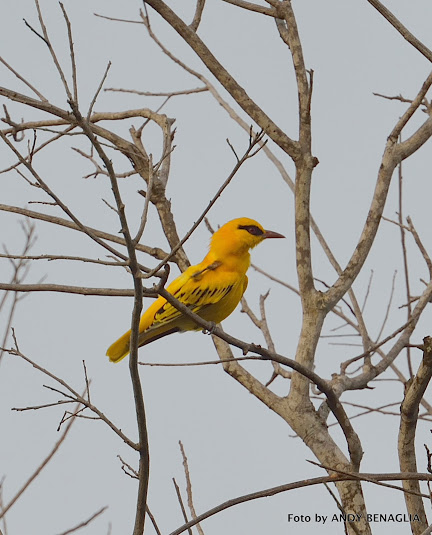 © Rumuruti
© Rumuruti
Male, Kenya, Diani Beach
Links:
Species Text Sabap1: http://sabap2.adu.org.za/docs/sabap1/544.pdf
http://sabap2.adu.org.za/species_info.p ... #menu_left
Terry Stevenson, John Fanshawe: Birds of East Africa: Kenya, Tanzania, Uganda, Rwanda, Burundi
 © Rumuruti
© RumurutiMale, Kenya, Diani Beach
Links:
Species Text Sabap1: http://sabap2.adu.org.za/docs/sabap1/544.pdf
http://sabap2.adu.org.za/species_info.p ... #menu_left
Terry Stevenson, John Fanshawe: Birds of East Africa: Kenya, Tanzania, Uganda, Rwanda, Burundi
Eurasian Golden Oriole
543. Eurasian Golden Oriole Oriolus oriolus (Europese Wielewaal)
Order: Passeriformes. Family: Oriolidae´
Description
Size medium: 22-24 cm. Iris crimson; bill dark pink; legs and feet grey.
Male: Mainly yellow; wings and tail mostly black ; lores black.
Female: Above yellowish green; below mainly white, washed yellow on flanks, streaked dusky; undertail yellow.
Juvenile: Like adult female, but more heavily streaked below; bill dusky.
Distribution
Breeds Europe and W Asia to India; migrates to Africa and India; widespread in South Africa, but largely absent from drier W.
Habitat
Coastal scrub, savanna, riverine Acacia, bushveld, drier woodland, exotic plantations, orchards.
Diet
Insects, fruit.
Breeding
Extralimital.
Call
Usually silent in S Africa; distinctive pleasant flutelike weelawoo or who-are-you, sometimes with harsher nasal quality; harsh rattling chrrr alarm note.
Status
Fairly common, but elusive, non-breedingeeding Palaearctic migrant, October to April; females and immatures far outnumber adult males.
Order: Passeriformes. Family: Oriolidae´
Description
Size medium: 22-24 cm. Iris crimson; bill dark pink; legs and feet grey.
Male: Mainly yellow; wings and tail mostly black ; lores black.
Female: Above yellowish green; below mainly white, washed yellow on flanks, streaked dusky; undertail yellow.
Juvenile: Like adult female, but more heavily streaked below; bill dusky.
Distribution
Breeds Europe and W Asia to India; migrates to Africa and India; widespread in South Africa, but largely absent from drier W.
Habitat
Coastal scrub, savanna, riverine Acacia, bushveld, drier woodland, exotic plantations, orchards.
Diet
Insects, fruit.
Breeding
Extralimital.
Call
Usually silent in S Africa; distinctive pleasant flutelike weelawoo or who-are-you, sometimes with harsher nasal quality; harsh rattling chrrr alarm note.
Status
Fairly common, but elusive, non-breedingeeding Palaearctic migrant, October to April; females and immatures far outnumber adult males.
Eurasian Golden Oriole Photos
543. Eurasian Golden Oriole Oriolus oriolus
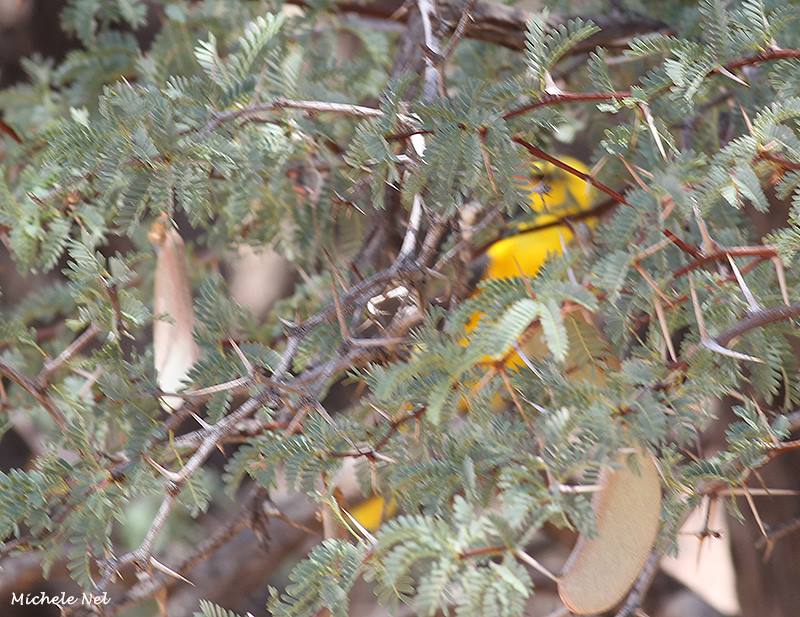 © Michele Nel
© Michele Nel
Kgalagadi Transfrontier Park, Urikaruus, 30/12/2015
Links:
Species Text Sabap1
Sapap2
Wikipedia
Newman's Birds of Southern Africa
 © Michele Nel
© Michele NelKgalagadi Transfrontier Park, Urikaruus, 30/12/2015
Links:
Species Text Sabap1
Sapap2
Wikipedia
Newman's Birds of Southern Africa
- Lisbeth
- Site Admin
- Posts: 67469
- Joined: Sat May 19, 2012 12:31 pm
- Country: Switzerland
- Location: Lugano
- Contact:
Black-headed Oriole
545. Black-headed Oriole Oriolus larvatus (Swartkopwielewaal)
Order: Passeriformes. Family: Oriolidae
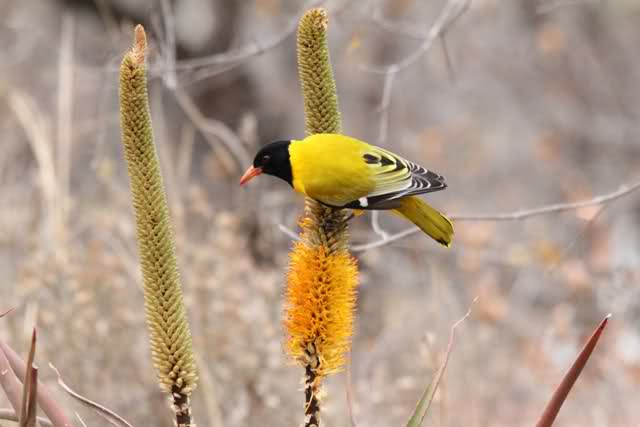 © pooky
© pooky
Description
Size 24 cm. Weight 65 g. It has a very striking appearance with a bright yellow body, contrasting black head and throat. Black wing- feathers fringed with white. Yellow underparts. Reddish flesh-coloured bill. Red eyes. The sexes are similar.
Juvenile has a dark bill, its head is dark brown, flecked with black and the bib is streaked.
Similar species: If seen from a distance, it might be confused with the rare Green-headed Oriole (in Mozambique) but it has a yellow (not green) back.
Distribution
Common in many areas of sub-Saharan Africa, from East Africa to southern Africa. Here it occurs throughout Mozambique, Botswana, Limpopo Province, KwaZulu-Natal and the Eastern Cape, with smaller populations in extreme nothern Namibia, Western Cape and the North-west Province.
Habitat
Mature woodland, also forest edge, exotic plantations and mature gardens. It is quite adaptable, occupying a variety of habitats, including Savanna woodland, miombo (Brachystegiai) woodland, coastal forest, parks, gardens, farmland with scattered trees and alien plantations.
Diet
The diet includes small fruit, nectar (Erythrina latissima Broad-leaved coral-tree, Greyvillea alien Silky oak, Aloe) and seeds, as well as large insects. The young are fed mostly with caterpillars.
Breeding
The nest is a deep cup made of strands of old-man's beard lichen (Usnea), moss, tendrils and grass woven together. It is usually placed between the stems of a fork in a horizontal branch, often far from the main tree trunk, usually 6-9 m above ground. Egg-laying season is from September-February, peaking from September-December. It lays 2-3 eggs, which are incubated for roughly 14-16 days. The chicks leave the nest after about 14-18 days.
Call
The voice is a liquid-sounding warble, accompanied by imitations and whistles pheeoo. A harsh cheer alarm call. Listen to Bird Call.
Status
Common resident.
Order: Passeriformes. Family: Oriolidae
 © pooky
© pookyDescription
Size 24 cm. Weight 65 g. It has a very striking appearance with a bright yellow body, contrasting black head and throat. Black wing- feathers fringed with white. Yellow underparts. Reddish flesh-coloured bill. Red eyes. The sexes are similar.
Juvenile has a dark bill, its head is dark brown, flecked with black and the bib is streaked.
Similar species: If seen from a distance, it might be confused with the rare Green-headed Oriole (in Mozambique) but it has a yellow (not green) back.
Distribution
Common in many areas of sub-Saharan Africa, from East Africa to southern Africa. Here it occurs throughout Mozambique, Botswana, Limpopo Province, KwaZulu-Natal and the Eastern Cape, with smaller populations in extreme nothern Namibia, Western Cape and the North-west Province.
Habitat
Mature woodland, also forest edge, exotic plantations and mature gardens. It is quite adaptable, occupying a variety of habitats, including Savanna woodland, miombo (Brachystegiai) woodland, coastal forest, parks, gardens, farmland with scattered trees and alien plantations.
Diet
The diet includes small fruit, nectar (Erythrina latissima Broad-leaved coral-tree, Greyvillea alien Silky oak, Aloe) and seeds, as well as large insects. The young are fed mostly with caterpillars.
Breeding
The nest is a deep cup made of strands of old-man's beard lichen (Usnea), moss, tendrils and grass woven together. It is usually placed between the stems of a fork in a horizontal branch, often far from the main tree trunk, usually 6-9 m above ground. Egg-laying season is from September-February, peaking from September-December. It lays 2-3 eggs, which are incubated for roughly 14-16 days. The chicks leave the nest after about 14-18 days.
Call
The voice is a liquid-sounding warble, accompanied by imitations and whistles pheeoo. A harsh cheer alarm call. Listen to Bird Call.
Status
Common resident.
"Education is the most powerful weapon which you can use to change the world." Nelson Mandela
The desire for equality must never exceed the demands of knowledge
The desire for equality must never exceed the demands of knowledge
- Lisbeth
- Site Admin
- Posts: 67469
- Joined: Sat May 19, 2012 12:31 pm
- Country: Switzerland
- Location: Lugano
- Contact:
Black-headed Oriole Photos
545. Black-headed Oriole Oriolus larvatus (Swartkopwielewaal)
 © Dewi
© Dewi
Kruger National Park, Shingwedzi
 © ExFmem
© ExFmem
Kruger National Park, Bateleur camp
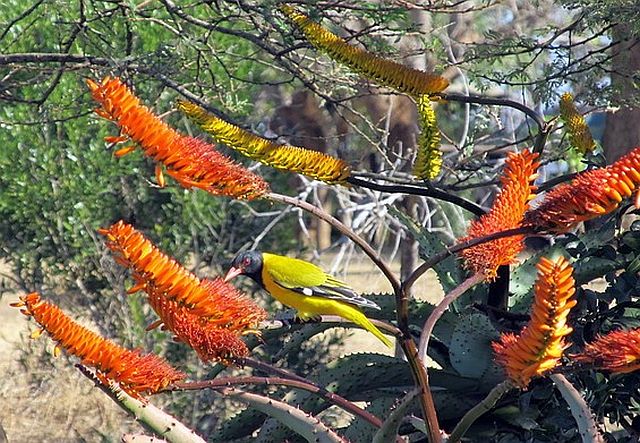 © Albert
© Albert
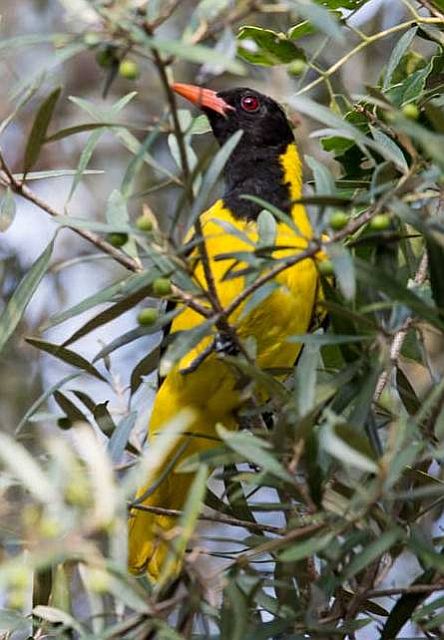 © Pumbaa
© Pumbaa
Links:
Species text Sabap1
Sabap2
 © Dewi
© Dewi Kruger National Park, Shingwedzi
 © ExFmem
© ExFmemKruger National Park, Bateleur camp
 © Albert
© Albert © Pumbaa
© Pumbaa Links:
Species text Sabap1
Sabap2
"Education is the most powerful weapon which you can use to change the world." Nelson Mandela
The desire for equality must never exceed the demands of knowledge
The desire for equality must never exceed the demands of knowledge
Family Dicruridae (Drongos)
The drongos are a family of small passerine birds of the Old World tropics, the Dicruridae. The genus Dicrurus contains 25 species of drongo.
These insectivorous birds are usually found in open forests or bush. Most are black or dark grey in colour, sometimes with metallic tints. They have long forked tails; some Asian species have elaborate tail decorations. They have short legs and sit very upright whilst perched, like a shrike.
The eyes are vivid red or orange, usually a giveaway that the bird is a drongo and not some unrelated black bird. The tail is typically long, often forked, with a complex, ornate shape. The head in most species bears some sort of crest. Body length in drongos ranges from 18 to 38 cm among species.
The beak is robust, hooked, notched behind the hooked end, and black in most species. There are long bristles, or retrices around the base of the beak. The wings are long and rounded or pointed. The legs, black in most species with strong feet and toes. Males are slightly larger than females, but both sexes are identical, or show slight variation, in coloration.
Drongos are notorious for aggressive behavior. They will fiercely defend their nests, and attack or harass predators like birds of prey, hornbills, crows, snakes, and humans. Drongos are accomplished, acrobatic flyers. In one recorded instance, a drongo individual escaped the clutches of a little sparrowhawk, which was chasing it in mid-air, by aerial acrobatics, outmaneuvering the predator.
Drongos forage, search for food, alone, in pairs, or in groups. The birds catch insects in mid-flight, often following larger animals in order to catch insects flushed out by the larger animals' motions. They may even follow grass fires, snagging insects escaping the flames. Drongos also glean insects from foliage and probe under bark for insects and related creatures. They may also forage in mixed-species flocks of one or more other bird species. Some drongo species just share in the abundance of insects driven out of hiding by the mixed-species flocks. Other species, especially during lean times, join mixed-species flocks but engage in kleptoparasitism, stealing food from other birds. They rob either directly, or, as in the forktailed drongos, by distracting another bird with alarm calls as it sees and closes in on an insect, then zooming in and snagging the insect.
When feeding on insects in mid-flight, drongos use long, wire-like bristles at the base of the beak, to guide insects into the beak. The bristles are modified feathers.
Drongos have an incredibly varied repertoire of voice sounds, even within a species, and often imitate the calls of other bird species. Some species imitate calls of birds of prey, if disturbed at nesting sites, to scare off intruders. One call of the spangled drongo sounds metallic, resembling the plucking of a taut wire.
Drongos form monogamous mating pairs. Male and female contribute in building the nest, incubating the eggs, and caring for the young. Two to four eggs are laid in a nest high in a tree. Nests are cup-shaped, and built with a hammock-style support, hanging from horizontal tree branches or forks. Monogamous pairs fiercely defend their territory, nest, and young. Other than those few facts, very little is known about other details of breeding behavior among drongos.
These insectivorous birds are usually found in open forests or bush. Most are black or dark grey in colour, sometimes with metallic tints. They have long forked tails; some Asian species have elaborate tail decorations. They have short legs and sit very upright whilst perched, like a shrike.
The eyes are vivid red or orange, usually a giveaway that the bird is a drongo and not some unrelated black bird. The tail is typically long, often forked, with a complex, ornate shape. The head in most species bears some sort of crest. Body length in drongos ranges from 18 to 38 cm among species.
The beak is robust, hooked, notched behind the hooked end, and black in most species. There are long bristles, or retrices around the base of the beak. The wings are long and rounded or pointed. The legs, black in most species with strong feet and toes. Males are slightly larger than females, but both sexes are identical, or show slight variation, in coloration.
Drongos are notorious for aggressive behavior. They will fiercely defend their nests, and attack or harass predators like birds of prey, hornbills, crows, snakes, and humans. Drongos are accomplished, acrobatic flyers. In one recorded instance, a drongo individual escaped the clutches of a little sparrowhawk, which was chasing it in mid-air, by aerial acrobatics, outmaneuvering the predator.
Drongos forage, search for food, alone, in pairs, or in groups. The birds catch insects in mid-flight, often following larger animals in order to catch insects flushed out by the larger animals' motions. They may even follow grass fires, snagging insects escaping the flames. Drongos also glean insects from foliage and probe under bark for insects and related creatures. They may also forage in mixed-species flocks of one or more other bird species. Some drongo species just share in the abundance of insects driven out of hiding by the mixed-species flocks. Other species, especially during lean times, join mixed-species flocks but engage in kleptoparasitism, stealing food from other birds. They rob either directly, or, as in the forktailed drongos, by distracting another bird with alarm calls as it sees and closes in on an insect, then zooming in and snagging the insect.
When feeding on insects in mid-flight, drongos use long, wire-like bristles at the base of the beak, to guide insects into the beak. The bristles are modified feathers.
Drongos have an incredibly varied repertoire of voice sounds, even within a species, and often imitate the calls of other bird species. Some species imitate calls of birds of prey, if disturbed at nesting sites, to scare off intruders. One call of the spangled drongo sounds metallic, resembling the plucking of a taut wire.
Drongos form monogamous mating pairs. Male and female contribute in building the nest, incubating the eggs, and caring for the young. Two to four eggs are laid in a nest high in a tree. Nests are cup-shaped, and built with a hammock-style support, hanging from horizontal tree branches or forks. Monogamous pairs fiercely defend their territory, nest, and young. Other than those few facts, very little is known about other details of breeding behavior among drongos.


